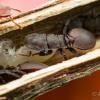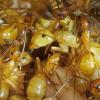As some of you may know, I'm going to the Florida Keys soon, and thanks to information provided by several people, I have found out it is legal to transport ants across state borders, and the one species I really have my eye on is Cephalotes varians. I have some really nice plans for their formicarium, and I'm set on a final design. A Red Mangrove swamp riparium, complete with mangrove roots and live Red Mangrove Trees. I'm going to order the Mangroves tonight, and I should be getting them before I leave for Florida on June 14th. I've already got the riparium all set up. I've set up the root system, the limestone, vines, and even a turtle shell. I'm just waiting for the water to clear so I can decorate it. I'm probably let the plants get all settled in for a few months before the introduction of the ants. I will be keeping the ants in a lab-style setup until the end of the summer when I introduce them to the riparium. I will be collecting some hollow twigs from Florida to put into the riparium for the ants to nest in. I will most likely be collecting twigs inhabited by another species, like Crematogaster or Colobopsis and get them out somehow and into another twig. I'm really excited to finish up the riparium and get the ants into it in a few months. I will post pictures once the riparium is completed.
- Formiculture.com
- Forums
- Gallery
- Members
- Member Map
- Chat



















